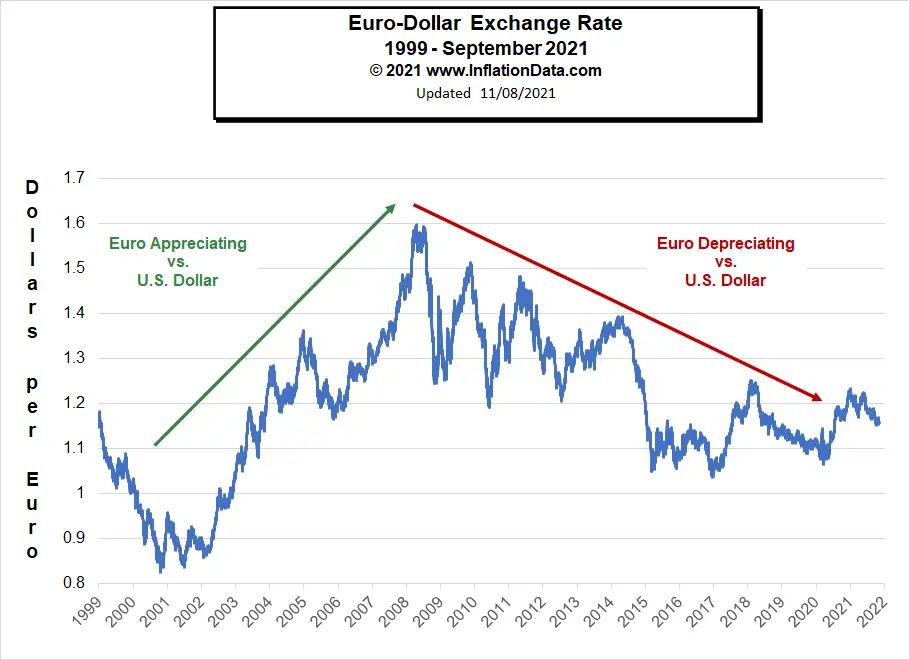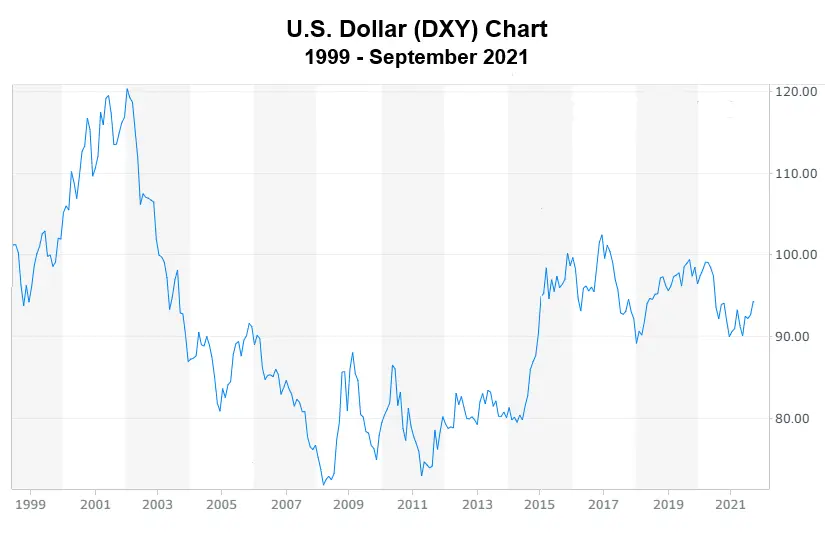One method investors can use to hedge against inflation is investing in a variety of foreign currencies. The key of course is which currencies you choose as an inflation hedge. You need to invest in those countries’ currencies, which will provide you with better protection from exchange rate changes to be successful at hedging against inflation.
Inflation in the United States has been relatively tame since the 1980s but it is currently at risk due to massive money creation by the FED via Quantitative Easing. However, inflation risk can be mitigated with the help of investment diversification. One method investors who are looking to protect their money against inflation would use is to seek a higher return than what they’re receiving now, hoping to outpace the depreciation of the currency due to inflation. For example, if the inflation rate is 5% you would need to get a return of greater than 5% in order to not lose purchasing power due to inflation.
History of Currency Fluctuation
In July 1944, delegates from the 44 Allied nations gathered in Bretton Woods, New Hampshire and named the U.S. Dollar the reserve currency of the world i.e. the world trade currency. So other countries needed the Dollar in order to engage in trade with one another. Prior to this countries traded gold with each other to settle their debts. After Bretton Woods, they could trade in Dollars instead and the U.S. Dollar was supposed to be pegged at $35 per ounce of gold. So theoretically everything was still based on gold.
But the U.S. began inflating the dollar and before long all that was left was an illusion that it was worth $35 an ounce. So wisely other countries began calling the United States bluff and requesting gold for $35 an ounce and eventually Nixon was forced to admit that we couldn’t afford to sell it at that price any longer and he was accused of “closing the Gold Window” i.e. no longer exchanging U.S. Dollars for a fixed amount of Gold. In response, currency exchange markets developed to determine the value of each currency via supply and demand rather than government fiat (i.e. law or edict). This free-market response created the opportunity for individuals to hedge their own currency against other currencies.
How Can Foreign Currencies Act as Inflation Hedge
A currency’s value is based upon a variety of factors including the supply of that currency (i.e. the amount printed by their Central Bank) and the demand for that currency. Demand for a currency is both local and international. If a country produces goods that are in demand on the international market then buyers need that currency in order to purchase the products. So a country that is a net exporter and has a responsible Central Bank will have a strong currency in the long run. While a country like Zimbabwe that produces virtually nothing for export and prints money to pay the bills will have a currency that ends in hyperinflation.
 In the above chart of the Euro vs. the U.S. Dollar, we can see that holding the Euro was preferable to holding the U.S. Dollar from late 2000 through 2008 on a long-term basis but there were many short-term periods where this would have been questionable. Then in 2008, the long-term trend shifted to favor the Dollar over the Euro. But once again there were many counter-trend rallies that moved in the opposite direction.
In the above chart of the Euro vs. the U.S. Dollar, we can see that holding the Euro was preferable to holding the U.S. Dollar from late 2000 through 2008 on a long-term basis but there were many short-term periods where this would have been questionable. Then in 2008, the long-term trend shifted to favor the Dollar over the Euro. But once again there were many counter-trend rallies that moved in the opposite direction.
For this reason, it is beneficial to diversify among not just two currencies but several. One tricky point when looking at currencies is that some are measured in dollars per (foreign currency) and others are measured as (foreign currency) per U.S. Dollar. Those charts will appear “upside-down” to American investors.
Comparing the Dollar Against a Basket of Currencies
As we’ve seen comparing against a single currency can be useful but if the currency we chose was unusually weak (or strong) it could give us a distorted picture of the true strength of our currency. Therefore it is useful to compare our currency (the currency that we use to buy and sell things in our daily life), to several currencies simultaneously. That is what the “DXY” index does. The “Dixie” uses a basket of currencies to calculate the value of the dollar.
The DXY is a weighted geometric mean of the dollar’s value relative to the following select currencies:
- Euro (EUR), 57.6% weight
- Japanese yen (JPY) 13.6% weight
- Pound sterling (GBP), 11.9% weight
- Canadian dollar (CAD), 9.1% weight
- Swedish krona (SEK), 4.2% weight
- Swiss franc (CHF) 3.6% weight
Looking at the DXY since 1999 we can see that it is very similar to the Euro (since the Euro makes up over half of the DXY). But it is inverted so it is easier to see when the chart is rising the Dollar is getting more valuable (compared to the other currencies) and when it is falling the Dollar is depreciating (i.e. suffering more inflation than other currencies).
What Makes a Currency a Good Inflation Hedge
There are several factors that make a currency a “haven” for investors:
- The backing of a stable political system
- The backing of a country or region with strong finances and economic growth prospects
- Liquid markets
- The tendency for foreign governments to hold the currency in reserves, and
- High confidence in the creditworthiness of the country or region that issues it
Other Reasons Countries can provide an Inflation hedge:
An economy based on oil or mineral reserves
Several countries that fall under this category are:
- Australia (Mineral Reserves)
- Nordic Countries (Oil Reserves)
- South Africa (Gold Producer)
- Canada (Gold and Minerals)
Other Economies that could possibly improve vs. the Dollar include:
- Brazil
- Norway
- China
- Russia
- Mexico
- Hong Kong
- Singapore
Summary
Many factors affect the effectiveness of currencies as an inflation hedge. These include their attractiveness relative to other global currencies. Currency appreciation occurs when investors consider the issuing economy strong. It means that foreign investors will buy investments from countries they perceive as having a healthy and prosperous future, driving up demand in their chosen currencies, resulting in higher prices for goods traveling into or out of those economies (and thus creating more wealth). On the other hand, a rise in the money supply can dilute the value of the currency. One way to protect against inflation risk is by diversifying over various currencies.
Note: Just as the U.S. Dollar has served as the trade currency of the world, English has served as the trade language of the world. Being a successful investor means speaking at least conversational English – make sure you know all the specific words that can help you with the investing.
Key Terms used in this article:
- Inflation
- Hyperinflation
- Diversification
- Fiat Currency
- Reserve Currency
- Quantitative Easing
- Inflation Hedge
- Using Risk to Combat Inflation
- Weighted Geometric Mean



Anyone look into MXN v USD as an inflation hedge?
Ed,
The Mexican Peso is certainly a possibility. It is included on the secondary list just before the summary. Its economy is closely tied to the U.S. as is Canada. It is an Oil producer so like all other alternatives to the Dollar a lot depends on timing. Currencies tend to be more like cruise ships than speedboats they tend to take a long time to change direction. So buying currencies that are appreciating against your own is a better strategy than trying to catch a turn.